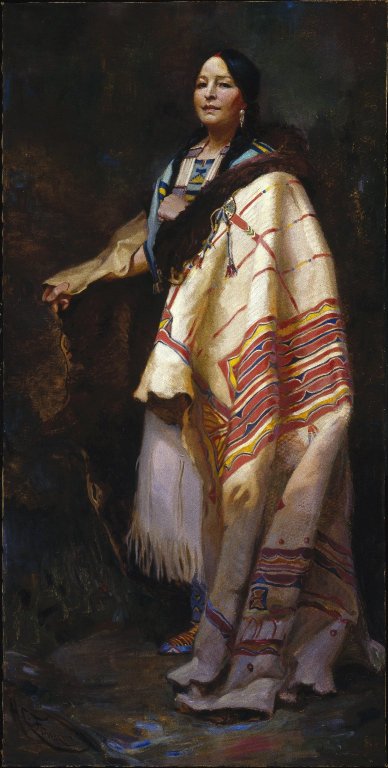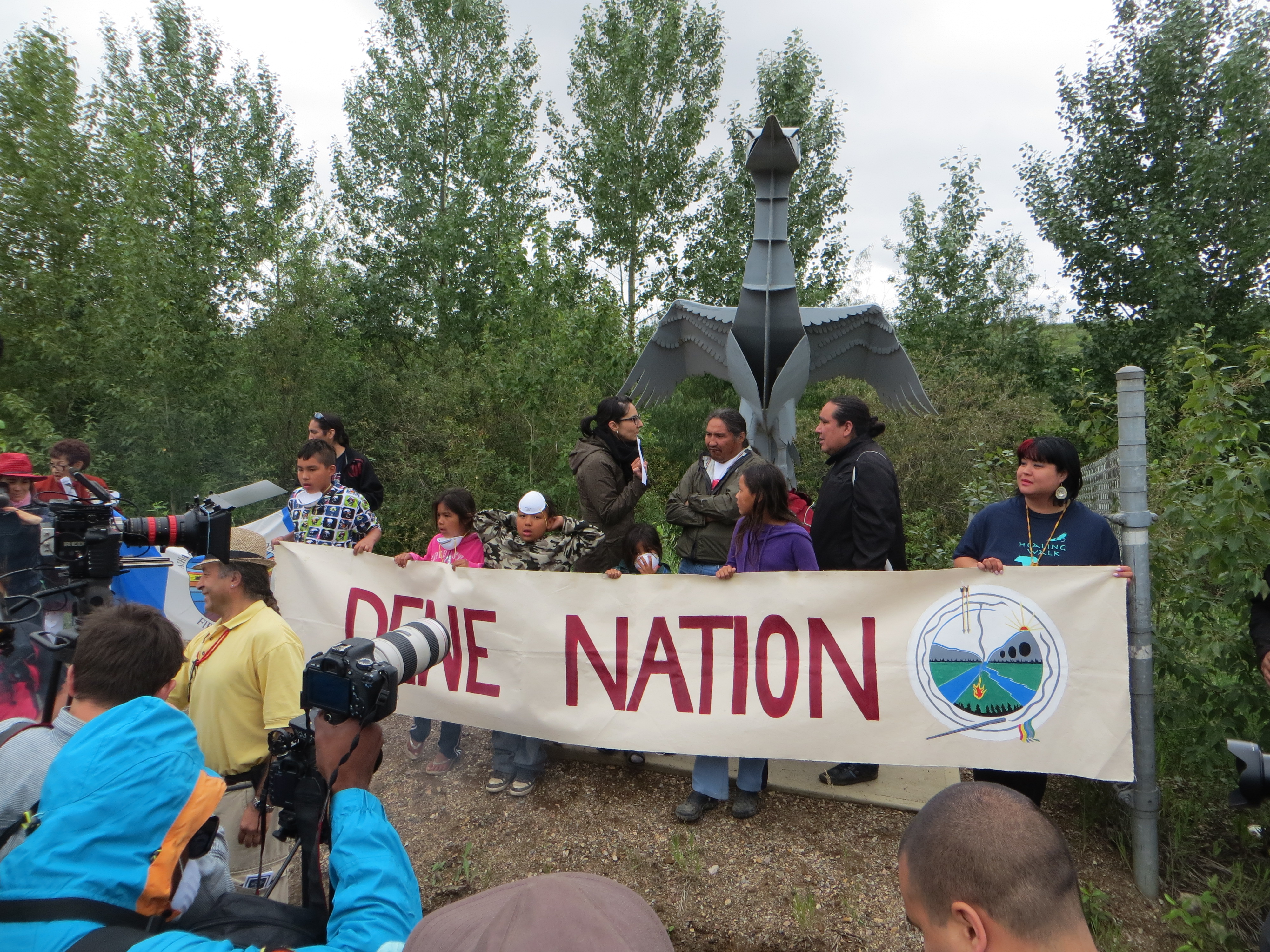Browse "Indigenous Peoples"
-
Article
Cradleboard
Historically, the cradleboard (or cradle board), was used by various Indigenous peoples to protect and carry babies. Securely bound to a thin rectangular board, a baby could be carried on its mother's back or put in a safe location while she performed her daily routine. In some communities, Indigenous peoples still use cradleboards.
"https://d2ttikhf7xbzbs.cloudfront.net/media/media/495aa08f-68c3-4963-8532-60d59ef3c2e3.jpg" // resources/views/front/categories/view.blade.php
https://d2ttikhf7xbzbs.cloudfront.net/media/media/495aa08f-68c3-4963-8532-60d59ef3c2e3.jpg
-
Article
Cree
Cree are the most populous and widely distributed Indigenous peoples in Canada. Other words the Cree use to describe themselves include nehiyawak, nihithaw, nehinaw and ininiw. Cree First Nations occupy territory in the Subarctic region from Alberta to Quebec, as well as portions of the Plains region in Alberta and Saskatchewan. According to 2021 census data, 223,745 people identified as having Cree ancestry and 86,475 people speak Cree languages.
"https://d2ttikhf7xbzbs.cloudfront.net/media/media/a78f261e-39c7-450a-bd19-466a86a5742c.jpg" // resources/views/front/categories/view.blade.php
https://d2ttikhf7xbzbs.cloudfront.net/media/media/a78f261e-39c7-450a-bd19-466a86a5742c.jpg
-
Article
Cree Code Talkers
Cree code talkers were an elite unit tasked with developing a coded system based on the Cree language for disguising military intelligence. They provided an invaluable service to Allied communications during the Second World War. Although their contributions remained hidden until recently, in part because the code talkers had been sworn to secrecy, their service helped to protect Western Allies and to win the war. Indeed, the Allies’ enemies were never able to break the code.
"https://d2ttikhf7xbzbs.cloudfront.net/media/media/d211edaf-1e6a-40f4-880a-cde6d355bf44.jpg" // resources/views/front/categories/view.blade.php
https://d2ttikhf7xbzbs.cloudfront.net/media/media/d211edaf-1e6a-40f4-880a-cde6d355bf44.jpg
-
Article
Cree Language
The Cree language (also called Cree-Montagnais-Naskapi) is spoken in many parts of Canada, from the Rocky Mountains in the west to Labrador in the east. Cree is also spoken in northern Montana in the United States. Often written in syllabics (i.e., symbols representing a combination of consonant and vowel, or just a consonant or vowel), Cree is one of the most widely spoken Indigenous languages in Canada. In the 2021 census, 86,475 people reported speaking Cree.
"https://d2ttikhf7xbzbs.cloudfront.net/media/media/b6607b22-8c55-4f10-86dd-a72dfcb1b740.jpg" // resources/views/front/categories/view.blade.php
https://d2ttikhf7xbzbs.cloudfront.net/media/media/b6607b22-8c55-4f10-86dd-a72dfcb1b740.jpg
-
Article
Dakota
The Dakota (Sioux) occupied what is now western Ontario and eastern Manitoba prior to 1200 AD, and western Manitoba and eastern Saskatchewan prior to 900 AD. After the War of 1812, the Dakota drew closer to their lands in the United States, but never abandoned their northern territory. In 2014, the Sioux Valley Dakota Nation in Manitoba became the first self-governing Indigenous nation on the Plains.
"https://d2ttikhf7xbzbs.cloudfront.net/media/media/5fa340b7-6e2b-4281-809f-2ccdfc1c406d.jpg" // resources/views/front/categories/view.blade.php
https://d2ttikhf7xbzbs.cloudfront.net/media/media/5fa340b7-6e2b-4281-809f-2ccdfc1c406d.jpg
-
Article
Daniels Case
On 14 April 2016, the Supreme Court of Canada ruled in Daniels v. Canada that the federal government, rather than provincial governments, holds the legal responsibility to legislate on issues related to Métis and Non-Status Indians. In a unanimous decision, the court found that Métis and Non-Status peoples are considered Indians under section 91(24) of the Constitution Act, 1867 — a section that concerns the federal government’s exclusive legislative powers. Recognition as Indians under this section of law is not the same as Indian Status, which is defined by the Indian Act. Therefore, the Daniels decision does not grant Indian Status to Métis or Non-Status peoples. However, the ruling could result in new discussions, negotiations and possible litigation with the federal government over land claims and access to education, health programs and other government services.
"https://d2ttikhf7xbzbs.cloudfront.net/media/media/7ac02b0f-118b-4ccb-b6dc-81f218b68954.jpg" // resources/views/front/categories/view.blade.php
https://d2ttikhf7xbzbs.cloudfront.net/media/media/7ac02b0f-118b-4ccb-b6dc-81f218b68954.jpg
-
Article
Darren Zack
Darren Zack (nicknamed Z-Man), pitcher in fastpitch softball (born 9 August 1960 in Garden River First Nation, ON). Compared in his skill to Babe Ruth, Zack dominated fastpitch softball in the 1990s. In addition to many other athletic accomplishments, Zack helped Team Canada win the Pan American Games fastpitch medal in 1991, 1995 and 1999. Though a fearsome competitor, Zack is known for his modest and humble demeanor off the field. He is actively involved in his Garden River First Nation community and in encouraging youth involvement in sports. (See also Baseball.)
"https://d2ttikhf7xbzbs.cloudfront.net/ZackZack27.jpg.jpg" // resources/views/front/categories/view.blade.php
https://d2ttikhf7xbzbs.cloudfront.net/ZackZack27.jpg.jpg
-
Article
David Greyeyes-Steele
David Georges Greyeyes-Steele, Plains Cree farmer, multi-sport athlete, soldier, war hero, First Nation chief, federal public servant (born 31 December 1914 on Muskeg Lake Cree Nation, SK; died 22 July 1996 in Saskatoon, SK). Greyeyes-Steele served in the Canadian Army during the Second World War and was awarded the Greek War Cross.
"https://d2ttikhf7xbzbs.cloudfront.net/MLCN-214-0004_141.jpg" // resources/views/front/categories/view.blade.php
https://d2ttikhf7xbzbs.cloudfront.net/MLCN-214-0004_141.jpg
-
Article
Demasduit
Demasduit (also known as Demasduwit, Shendoreth, Waunathoake, and Mary March), creator of a Beothuk dictionary (born 1796; died 8 January 1820 at Bay of Exploits, Newfoundland). Demasduit was a Beothuk woman taken captive by English fishers in 1819. She was subsequently sent to an Anglican missionary where she created a list of Beothuk vocabulary. After her death, her remains and those of her husband were taken to Scotland. After much lobbying, the remains were returned to Newfoundland in 2020. The Government of Canada has recognized Demasduit as a Person of National Historic Significance.
"https://d2ttikhf7xbzbs.cloudfront.net/media/media/d98583ec-b0c6-4d27-932f-af95a68bd8a3.jpg" // resources/views/front/categories/view.blade.php
https://d2ttikhf7xbzbs.cloudfront.net/media/media/d98583ec-b0c6-4d27-932f-af95a68bd8a3.jpg
-
Article
Dene
Dene comprise a far-reaching cultural and linguistic family, stretching from the Canadian North and Alaska to the American southwest. In Canada, Dene, which means “the people” in their language, comprise a variety of First Nations, some of which include the Denesuline (Chipewyan), Tlicho (Dogrib) and Dinjii Zhuh (Gwich’in). Dene are also known as Athabascan, Athabaskan, Athapascan or Athapaskan peoples. In the 2021 census, 45,895 people identified as having ancestry of Dene origins, which includes Dene, Dane-zaa, Dakelh, Tsilhqot’in, Denesuline, Dene Tha’, Gwich’in, Kaska Dena, Sahtu, Tahltan, Tlicho, Tlingit, Tse’khene (Sekani), Tsuut’ina (Sarcee), Tutchone and Wet’suwet’en. In that census, there were 18,360 people who identified as Dene without specifying further.
"https://d2ttikhf7xbzbs.cloudfront.net/media/media/bd07ff31-bf6a-42a5-9636-8159f6b0c9ab.jpg" // resources/views/front/categories/view.blade.php
https://d2ttikhf7xbzbs.cloudfront.net/media/media/bd07ff31-bf6a-42a5-9636-8159f6b0c9ab.jpg
-
Article
Dick Patrick
Dominic (Dick) Patrick, war hero, activist (born 1920 in Saik’uz First Nation, near Vanderhoof, BC; died 1980 in Saik’uz First Nation).
"https://d2ttikhf7xbzbs.cloudfront.net/DickPatrick/Dick_Patrick_Commendation_web.jpg" // resources/views/front/categories/view.blade.php
https://d2ttikhf7xbzbs.cloudfront.net/DickPatrick/Dick_Patrick_Commendation_web.jpg
-
Article
Ditidaht
Ditidaht (meaning “people along the way” or “people along the coast” in their language) is a Nuu-chah-nulth nation residing on the west coast of Vancouver Island. At present, the main permanently occupied Ditidaht village is situated in Malachan, a settlement that lies at the head of Nitinat Lake. As of October 2021, the federal government counts 775 registered members of the Ditidaht nation.
"https://development.thecanadianencyclopedia.ca/images/tce_placeholder.jpg?v=e9dca980c9bdb3aa11e832e7ea94f5d9" // resources/views/front/categories/view.blade.php
https://development.thecanadianencyclopedia.ca/images/tce_placeholder.jpg?v=e9dca980c9bdb3aa11e832e7ea94f5d9
-
Article
Gabriel Dumont
Gabriel Dumont, Métis leader (born December 1837 at Red River Settlement; died 19 May 1906 at Bellevue, SK). Dumont rose to political prominence in an age of declining buffalo herds. He fought for decades for the economic prosperity and political independence of his people. Dumont was a prominent hunt chief and warrior, but is best known for his role in the 1885 North-West Resistance as a key Métis military commander and ally of Louis Riel. Dumont remains a popular Métis folk hero, remembered for his selflessness and bravery during the conflict of 1885 and for his unrivaled skill as a Métis hunt chief.
"https://d2ttikhf7xbzbs.cloudfront.net/media/media/93488558-8f0b-4e99-9620-b5734d1bc42f.jpg" // resources/views/front/categories/view.blade.php
https://d2ttikhf7xbzbs.cloudfront.net/media/media/93488558-8f0b-4e99-9620-b5734d1bc42f.jpg
-
Article
Eddy Cobiness
Eddy “Doc” Cobiness, Ojibwe (Anishinaabe) artist (born 17 July 1933 in Warroad, Minnesota, United States; died 1 January 1996 in Winnipeg, MB). He was a founding and eminent member of Professional Native Indian Artists Inc., known widely as the Indian Group of Seven. Cobiness’s artwork was featured in many prominent collections, including those of Queen Elizabeth II, former Canadian prime minister Jean Chrétien and Academy Award-winning actor Charlton Heston. Influenced by Pablo Picasso, Cobiness worked in many mediums, including ink, watercolour, oil and acrylic, and his stylized brush strokes were referred to as “flowing.” Cobiness’s artwork often depicted animals and the natural world.
"https://d2ttikhf7xbzbs.cloudfront.net/EddyCobiness/6079029801_ff15e2a46b_b.jpg" // resources/views/front/categories/view.blade.php
https://d2ttikhf7xbzbs.cloudfront.net/EddyCobiness/6079029801_ff15e2a46b_b.jpg
-
Article
Edward Ahenakew
Edward Ahenakew, Anglican clergyman of Cree ancestry (born 11 June 1885 at Sandy Lake Indian Reserve [now the Ahtahkakoop First Nation] in central Saskatchewan; died 12 July 1961 in Dauphin, Manitoba). Proud of his heritage and a firm believer in the Christian faith, Ahenakew dedicated his life to missionary work on reserves, promoting the Cree language and bettering education on reserves.
"https://d2ttikhf7xbzbs.cloudfront.net/media/media/840b38bf-6c6d-4199-94b6-8fb89c81cc51.jpg" // resources/views/front/categories/view.blade.php
https://d2ttikhf7xbzbs.cloudfront.net/media/media/840b38bf-6c6d-4199-94b6-8fb89c81cc51.jpg
